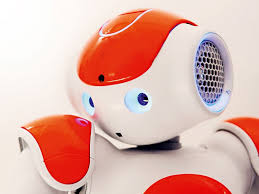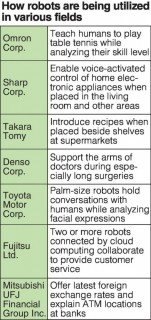Loading
Search
▼ Robot Developers See New Uses Beyond Factory Work
- Category:Other
Domestic companies in various fields, including automakers, electronics makers and banks, are accelerating the development of robots in anticipation of growing demand for them to perform tasks outside of industrial purposes, such as being capable of having a conversation with people at home or in stores.
Japan leads the world in terms of competitiveness for industrial robots used in factories. Companies are capitalizing on this strength.
Various kinds of robots are being exhibited at the CEATEC (Combined Exhibition of Advanced Technologies) Japan 2016 expo, which started Tuesday at the Makuhari Messe convention center in Mihama Ward, Chiba.
In the financial sector, Mitsubishi UFJ Financial Group, Inc. displayed the humanoid robot NAO, which has been introduced at its branches. NAO is connected to IBM Corp.’s artificial intelligence platform Watson through wireless communication, and explains currency exchange rates or the location of automated teller machines to customers.
Toyota Motor Corp.’s Kirobo Mini is capable of recognizing human emotions from facial expressions with its camera and sensors and says things like, “Are you angry?” The robot, measuring 10 centimeters high when seated and weighing 183 grams, will be put on the market this winter for ¥39,800, excluding tax.
Cutting-edge technology exhibited at CEATEC also includes a robot developed by Fujitsu Ltd. that attends to customers. Linked by the internet, the robots can share roles among themselves.
Robots have so far been utilized mainly for industrial purposes at production plants for automobiles and other products. In Japan, manufacturers including Fanuc Corp. and Yaskawa Electric Corp. have some of the highest shipment volumes in the world.
Markets for robots, other than those for industrial use, are expected to grow rapidly in the future. Last year, the government mapped out a “New Robot Strategy,” setting the goal of expanding the robot market in nonmanufacturing sectors such as medical services and nursing care to ¥1.2 trillion by 2020, or 20 times as much as in 2015. To achieve this goal, the government is supporting related companies. It also aims to help resolve labor shortages caused by the declining population.
In addition to government assistance, the remarkable development of sensors and AI in recent years is also giving a boost to the development of robots capable of interacting with people, even beyond industry.
Yusuke Nakada, a researcher at Mitsubishi UFJ Research and Consulting Co., said: “Japan has an advantage in robot technology. There will be a chance to lead the market if [Japanese companies] develop robots by imagining various scenarios in which they can be utilized.”
Robots have so far been utilized mainly for industrial purposes at production plants for automobiles and other products. In Japan, manufacturers including Fanuc Corp. and Yaskawa Electric Corp. have some of the highest shipment volumes in the world.
Markets for robots, other than those for industrial use, are expected to grow rapidly in the future. Last year, the government mapped out a “New Robot Strategy,” setting the goal of expanding the robot market in nonmanufacturing sectors such as medical services and nursing care to ¥1.2 trillion by 2020, or 20 times as much as in 2015. To achieve this goal, the government is supporting related companies. It also aims to help resolve labor shortages caused by the declining population.
In addition to government assistance, the remarkable development of sensors and AI in recent years is also giving a boost to the development of robots capable of interacting with people, even beyond industry.
Yusuke Nakada, a researcher at Mitsubishi UFJ Research and Consulting Co., said: “Japan has an advantage in robot technology. There will be a chance to lead the market if [Japanese companies] develop robots by imagining various scenarios in which they can be utilized.”
- October 6, 2016
- Comment (0)
- Trackback(0)



